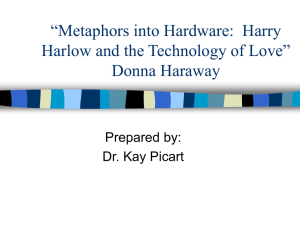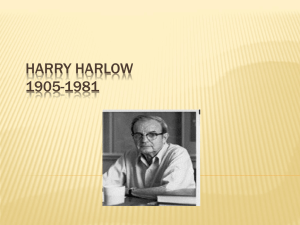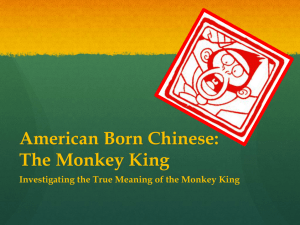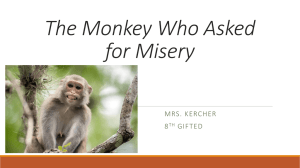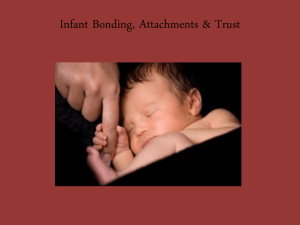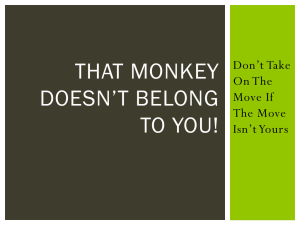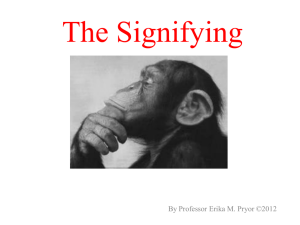File
advertisement
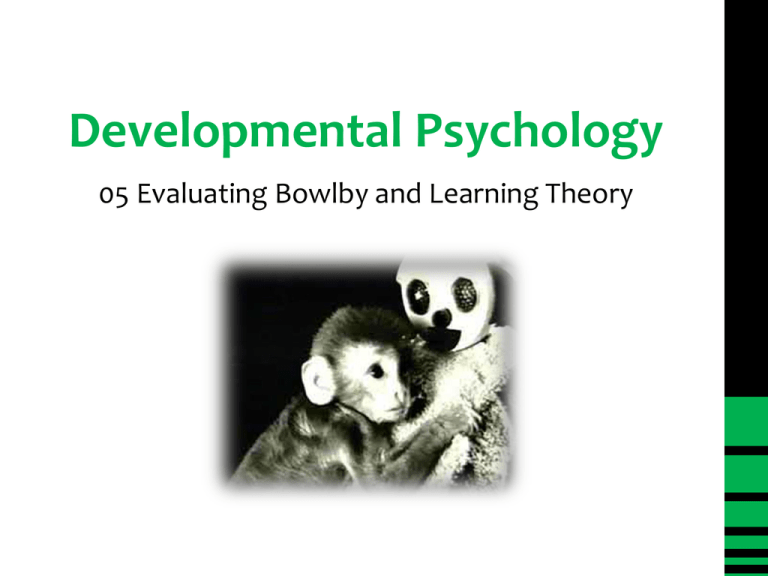
Developmental Psychology 05 Evaluating Bowlby and Learning Theory Attachment Crossword Task: Complete the ‘attachment crossword’ to help you revise the key terms from Bowlby’s Theory and Learning Theory. 5 minutes Learning Theory vs. Bowlby Today’s objectives: To apply key research to Learning Theory and Bowlby’s Theory and use this research to evaluate these two theories of attachment. Vs. Evaluating Bowlby and Learning Theory In today’s lesson you will use 3 studies to evaluate both Bowlby’s Theory and Learning Theory. Some studies can be used to support/refute both theories and therefore it is essential you know how these studies apply to BOTH theories… Learning Theory Bowlby’s Theory Harlow & Harlow (1962) Weakness Harlow & Harlow (1962) Weakness Lorenz (1952) Weakness Lorenz (1952) Strength Rutter et al. (1998) Strength Rutter et al. (1998) Weakness Harlow & Harlow (1962) Task 1: Read the Harlow & Harlow (1962) experiment and write a short summary – less than 100 summarising this experiment. Task 2: In groups, use 2 mini-whiteboards. Write ‘Learning Theory’ at the top of one and ‘Bowlby’s Theory’ on the other. Then answer the following questions… Does Harlow & Harlow (1962) support/refute this theory? Why? Now, lets try to write 2 burger paragraphs together… What is your evaluation point: One weakness comes from a study by Harlow & Harlow (1962). They found that…baby monkeys spent more time with a soft towelling monkey (18 hours a day) in comparison to a wire monkey (1 hour a day) which provided food. In addition, when the baby monkey was frightened, it would run to the soft towelling monkey and not the wire monkey. Harlow & Harlow (1962) Evaluating Learning Theory This refutes (goes against) the learning theory of attachment because…according to Classical Conditioning, children form attachments with their caregivers because they make an association between their caregiver and being relived from hunger. This is a weakness because…Harlow & Harlow found that baby monkeys form attachments for comfort and not food, as stated in the classical conditioning theory. What is your evaluation point: One weakness comes from a study by Harlow & Harlow (1962). Harlow & Harlow (1962) Evaluating Bowlby’s Theory They found that…baby monkeys spent more time with a soft towelling monkey (18 hours a day) in comparison to a wire monkey (1 hour a day) which provided food. In addition, when the baby monkey was frightened, it would run to the soft towelling monkey and not the wire monkey. This refutes Bowlby’s theory of attachment because…Bowlby argues that we form attachments for adaptive (survival) reasons and in Harlow & Harlow’s research they found the baby monkey would ‘attach’ to the soft towelling monkey. This is a strength/weakness because…the monkey would attach to the soft towelling monkey which would provide no survival benefit and not the wire monkey (which did provide food) posing a problem for Bowlby. Evaluation… Task: In a group of 4, assign one person to each of the following experiments Lorenz (1952) – Weakness of Learning Theory Lorenz (1952) – Strength of Bowlby’s Theory Rutter et al. (1998) – Strength of Learning Theory Rutter et al. (1998) – Weakness of Learning Theory Task 1: On your own, read the experiment and write your own summary of the study in less than 100 words. Then write a ‘Burger Paragraph’ explaining why your study is a strength or weakness of learning theory. Task 2: In your groups, take turns in explaining your study and Burger Paragraph to the rest of the group. Essays for Attachment… Outline and evaluate an evolutionary explanation of attachment. (12 marks). Outline and evaluate a learning theory of attachment (12 marks). Task: You have 10 minutes to plan both essays and then you will have 24 minutes to write them. What is your evaluation point: One strength/weakness comes from… They found that… Harlow & Harlow (1962) Evaluating Learning Theory This supports/refutes [Insert Name] theory because… This is a strength/weakness because… What is your evaluation point: One strength/weakness comes from… They found that… Harlow & Harlow (1962) Evaluating Bowlby’s Theory This supports/refutes [Insert Name] theory because… This is a strength/weakness because…
